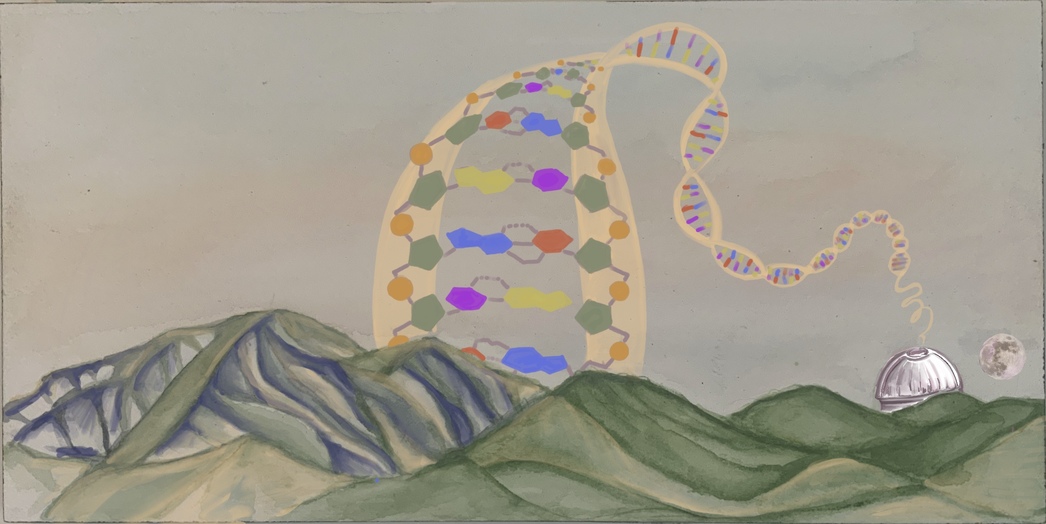
Illustration by Isabel Swafford for Caltech Letters over 'Braun Laboratories at Caltech', captured by the author.
Viewpoint articles are a vehicle for members of the Caltech community to express their opinions on issues surrounding the interface of science and society. The views expressed here do not necessarily reflect the views of Caltech or the editorial board of Caltech Letters. Please see our disclaimer.
Caltech recently received the second-largest gift ever donated to a US university, a whopping $750 million from the Resnick family, meant to support research into sustainable technologies and means of combating climate change. This money will be used to erect a new building, bolster Caltech’s endowment, and fund environmentally-oriented research. Researchers who receive these funds will retain full self-determination over their work. It is tempting to unquestioningly celebrate this gift and the freedom to use it, but I believe that it is not ethical to pursue research using these funds without critically examining our relationship with the Resnicks. As scientists, we mold our work, our speech, and our way of interpreting the world in pursuit of objectivity. However, we often end up deluding ourselves and each other into believing that we actually are objective beings. Such beliefs are dangerous when we encounter ethical dilemmas: a person who believes themself to be objective can always justify their actions as “right.” As we consider how the Resnick gift should be employed, we need to be clear about how we judge the ethics of its use.
When we think of moral dilemmas, we usually think of dramatic scenarios: for example, the trolley problem or, in the case of scientific research, how long artificial embryos should be allowed to develop. But the vast majority of ethical choices scientists face are mundane. These choices are typically not even related to experiments, but rather to funding: from whom to procure it and how to compete for it. In the US, scientists usually turn to a combination of government agencies and private organizations. The government agencies, such as the National Science Foundation (NSF), usually have a very broad scope and support many diverse scientific ventures. The private foundations typically have very concrete missions, such as developing treatments for a particular disease. Despite the differences in breadth of focus between public and private sponsors, US scientists typically justify their applications for funding by claiming that their research will contribute to the “Greater Good”. These contributions are codified in grant and proposal guidelines and are sometimes termed the “broader impacts” of the work. For example, the Center for Advancing Research Impact in Society (ARIS) developed a guiding document to advise grant reviewers and program managers on how to evaluate NSF grant applications, underscoring the importance of the quality of their proposed broader impacts. This document states that a key factor in evaluating a given proposal is its potential “to benefit society or advance desired societal outcomes.” In other words, while scientific research directions are typically driven by myriad human motivations like aspiration, ego, and curiosity, they have to be recontextualized and sold as socially beneficial.
Relying on the strength of the broader impacts of their research, scientists make a utilitarian claim. Maximizing utility, broadly defined as achieving the most good for the most people, is an important motivation and should be at the foundation of public policy. But I contend that it can never be an objective goal. There is no universal definition of “Good,” and, for most definitions, this Good cannot be evaluated within our lifetimes. Utilitarianism usually cannot be a moral basis for a scientist to pursue their work ethically because the work’s utility cannot be guaranteed. In applications for funding, utility often emerges as either an afterthought or an assertion provided solely to procure funding. Unless a different, non-utilitarian moral ground underlies the work, the scientist’s ethical obligations as a human being cannot be satisfied by their proposed research alone.
To give a concrete, admittedly dramatic, example of the tension between utilitarianism, funding, and social values, I present the case of Martin Couney:
In the late 19th and early 20th centuries, when the burgeoning eugenics movement held “Better Babies” contests (e.g., which blue-eyed white baby is “scientifically best?”), and most doctors advocated that premature infants be left to die, Martin Couney developed incubators that saved thousands of these children, including his own daughter1. Couney did this as a showman who continually lied about his credentials: In 1898, he began traveling to expositions and fairgrounds in the US, with infants on display in his incubators as sideshows, all the while claiming to have a European medical license and training under Dr. Pierre Budin, a founder of modern neonatal care, neither of which was true2. In 1903 and 1904, respectively, Couney established permanent expositions on Coney Island and in Atlantic City that both ran for nearly forty years3. By charging the peeping public for admission, Couney was able to fully cover the cost of the medical care, sanitation, and nurses’ wages at no cost to the desperate parents who brought him their newborns. When the infants matured, they were returned to their families. Couney saved roughly 85% of the premature babies in his shows, in contrast to the roughly 25% that were surviving standard care. Gradually, Couney garnered enough respect to win over the medical establishment. His influence went beyond saving the preemies to proving that they could grow up to be indistinguishable from those who had been born at full-term. As one example, possibly due to the simple fact that oxygen was too expensive to provide in excess in Couney’s sideshows, infants under his care avoided developing retrolental fibroplasia, blindness that plagued children who were given too much oxygen in hospital incubators4. The approximately 6,500 people saved by Couney’s enterprise grew up to have children, grandchildren, and great-grandchildren of their own; there are likely tens of thousands of people alive today because of him. Couney’s work made him a kind of anti-eugenicist, aligning him against the utilitarianism of his time: the reason why the medical establishment did not bother trying to develop means of saving premature infants was that those children were deemed to not be worth the effort. Preemies were considered weaklings who would be inferior to the “better babies.”
This story underscores the capricious nature of utilitarianism. Back then, as it would now, the way that Couney funded his work delegitimized his efforts5. However, the fact that there was no social ethic, no “legitimate” establishment that would support saving premature infants, created the possibility for Couney’s success. Couney wanted to save those children, to spread “preemie propaganda”6, and found an unorthodox way to do it, while also accruing significant wealth. Today, after the fact, it is tempting to explain why what Couney did was right by making a utilitarian argument, that the ends clearly justified the means, but this retroactive argument is misleading. We now think that the ends have justified the means because our social values have changed (for the better), and we, as a society, agree that the lives of premature infants are worth saving. This change in values is not due to us having followed a utilitarian ethic. It is due to the non-utilitarian work of people like Couney.
This example may seem incomparable to a gift of $750 million from one established group (the Resnicks) to another (Caltech), but Couney’s revenue was actually millions of dollars in today’s value7. The connection that I want to draw between the two cases rests on their shared dissonance between utility, funding, and social values. To paraphrase one of Lily E. Kay’s opening arguments in The Molecular Vision of Life8, by participating in the given funding system, the scientist also participates in forming a consensus of values and priorities with the funder9. This happens even when the scientist’s motivations—such as general curiosity, desire for social progress, or self-interest—have nothing to do with their relationship with the sponsor. This consensus of values and priorities, which constitute the social program of the funder, is more beneficial to the funder than the scientist. While a funding agency provides an individual scientist a sort of legitimacy (evidence that the scientist was able to convince someone to give them money), the fact that the agency unified a whole field of research solidifies that agency’s influence on society. Thus, uncritically using money from a given group strengthens it, regardless of what the funds are used toward. Neither a utilitarian claim nor a successful procurement of funding can serve as evidence of ethical work.
So, in order to use the Resnick gift ethically, we must critically consider their values and priorities, as evidenced by their practices. The Resnicks made their fortune through questionable business practices, such as shipping drinking water from Fiji to the US and taking control of a previously California-owned waterbank. Accepting their donation raises questions about where the line between reputation laundering and reparation is drawn. For example, by conducting research with their money, are we justifying the way in which they accrued their wealth? Have the Resnicks given enough money directly to Fiji (via taxes, donations, investments, or reparations) to qualify as having made a restitution? Such questions are not restricted to the Resnick gift and apply generally to issues of accepting money for research from harmful enterprises, such as from fossil fuel companies. However, the Resnick gift is unique in its size and intention, being the first of its magnitude to directly aim for environmental improvement. It will cause reverberations in donations to other universities, and so it behooves us to establish a system of ethics for using it from the outset.
We already know part of how Caltech will use the gift: $400 million will go into Caltech’s endowment, $100 million will go towards a new building, and $250 million will be applied toward research via the Resnick Sustainability Institute (RSI). The RSI has four interconnected initiatives: “Sunlight to Everything”, which aims to use solar energy to combat pollution and greenhouse gasses; “Climate Science”, which aims to mitigate the effects of global warming; “Water Resources”, which aims to improve the availability of drinking water; and “Ecology and Biosphere Engineering”, which aims to understand and mitigate negative human impacts on ecosystems. This mass project is uniquely poised to involve every branch of science found at Caltech. There is no doubt in my mind that research funded through the RSI will lead to applicable, beneficial, and interesting outcomes. But this research is unlikely to undo the direct harm done to the environment by the Resnicks’ companies, despite all the freedom that a private donation allows. Undoing this harm would require Caltech to start an explicit program to assess and address environmental damage done to Fiji, the Pacific Ocean, and California’s freshwater reserves by Caltech’s biggest donor.

'Baxter Hall at Caltech', captured by the author.
Lev Tsypin
The question stands before every scientist at Caltech who is, or wants to be, funded through the RSI: Do you support the Resnicks’ practices? If you use their money and do not actually resist their business ethic, then it does not matter what your reflexive answer is; you are participating in the formation of the consensus that these practices are okay. As a member of society, you should feel free and welcome to follow your curiosity, invent new solutions to social problems, and pursue the work that you believe in. But you should also remember who is allowing you to do so. Scientists stand to gain from clarity about how funding shapes research and about how to formulate an ethical system in a changing world, and demonstrating this clarity will serve to increase public trust in science. There are several key questions that each scientist should engage with:
- What is the social program of the group funding me or the research I’m invested in?
- Are the funders using researchers as props to justify their social programs?
- By lending credibility to the funders, is my research supporting something that I stand against?
- If yes, does the funding provide an excuse to keep doing what I have been doing, or is it an opportunity to subvert the practices or social program I oppose?
It is almost always easier to keep doing what you have been doing, and it is sometimes right to do so. Ultimately, different people will have different tolerances for how much cognitive dissonance they can bear when their work supports a social program that they stand against. When I ask myself the above questions, I find myself where I believe most scientists are: the opaque moral gray. I find my own work interesting and worthwhile, insofar as all fundamental, creative pursuits are important human practices. But I do not believe that, during my PhD, I will be able to pursue research that compensates for the social programs of some of my funders (e.g., the Army Research Office). I have to live with this fact, and how I do so is the ethical choice before me. The way I see it, sticking to my research and doing nothing outside of it to improve my environment would be wrong.
In the case of the Resnick gift, my non-utilitarian stance is that money should be used to pursue sustainability research and combat climate change, as the gift was intended to be used, but that this cannot be done innocently. Guided by a non-utilitarian ethic, our use of the money ought to be paired with action that is separate from the exchange that the Resnicks and Caltech have made. This action should serve to subvert the aspects of the Resnick companies’ social programs that we disagree with and move us beyond a zero-sum moral accounting.
If you find yourself in a similar position to mine, the call to action is three-fold: improve the immediate social space around us, improve the institution(s) we are a part of, and improve the society we find ourselves in. It is not possible for an individual to address or work on all scales at once, but there are a lot of issues that can be addressed on an approximately local scale through collective advocacy. In the case of Caltech, an obvious small-scale example is to combat food waste (it is absurd that we received $750 million for sustainability research without any infrastructure for composting on campus). More generally in academia, we should move to involve trainees in decision-making (e.g., admission, hiring, tenure, and curricula, which would foster increased trust and understanding between faculty and their mentees). Graduate students, postdocs, and staff should collectively advocate for more equitable working conditions, grievance procedures, and compensation. Labs, be they in academia, non-profit organizations, or industry, should have explicit conversations about their values and how they align or conflict with those of their funding sources. These are opportunities to supplement research in a way that centers actual, subjective values and thus sculpts the norms of scientific conduct. These are opportunities to do something good.
Acknowledgements
This piece has been in the works for a year, and has been shaped by many people. I want to thank Audrey Massman for introducing me to Martin Couney’s story during a tabletop role playing game. I’ve had many conversations about the ethics of scientific funding, including with members of the Newman Lab antiracism discussion subgroup, with whom I read Lily E. Kay’s Molecular Vision of Life, and I want to particularly thank Elise Tookmanian and Georgia Squyres as co-leaders of that group. I’ve had long discussions about how to improve Caltech with many of my friends and colleagues, which influenced the tone and direction of this piece, and I want to thank Fayth Tan, Krystal Vasquez, Aditi Narayanan, and Hannah Weller for helping me crystalize my perspective on the systems of power that are at play within academia. I’m hugely grateful to my adviser, Dianne Newman, who has been nothing but supportive of me when I have come into conflict with Caltech, who finds the humor within our personal disagreements, and who has ensured my success as a PhD student even as I have gotten increasingly active on campus outside the lab. Thank you to the editors, Melba Nuzen, Nicole Wallack, Skyler Ware, and Heidi Klumpe for their careful and constructive criticism of this piece. Most of all, I’m grateful for my fiancée, Yana Zlochistaya, who has read, thought about, and discussed this piece with me since its inception.
Footnotes
1: Prentice, C., 2016. Miracle at Coney Island: How a sideshow doctor saved thousands of babies and transformed American medicine. p. 32
2: Ibid. pp. 51-55
3: Ibid. p. 23, p. 29, and p. 70
4: Ibid. p. 67
5: Ibid. p. 27
6: Ibid. p. 65
7: Ibid. see, for example, p. 29
8: Kay, LE. 1996. The Molecular Vision of Life: Caltech, the Rockefeller Foundation, and the rise of the new biology. Oxford University Press, USA
9: Ibid. p. 10




